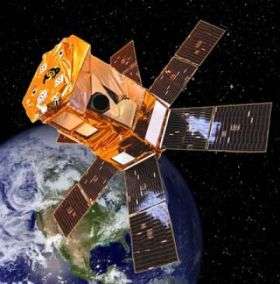CU-Boulder returns $3M to NASA in satellite design, operation cost savings

The University of Colorado at Boulder took an unusual step today by returning nearly $3 million in cost savings to NASA for an award-winning satellite mission designed, built and controlled by the university to study how the sun's variation influences Earth's climate and atmosphere.
Known as the Solar Radiation and Climate Experiment, or SORCE, the $100 million mission centered at CU-Boulder's Laboratory for Atmospheric and Space Physics was launched by NASA in 2003 and is controlled from the LASP Space Technology Building at the CU Research Park. A $2,997,000 check for the cost savings from SORCE development and operations was presented by LASP officials to Ed Chang, NASA SORCE manager from the Goddard Spaceflight Center in Greenbelt, Md., at a LASP event June 17.
The SORCE mission budget total of $100 million from 1999 to 2008 included the design and development of the satellite's five instruments, as well as five-and-one-half years of operations, and did not include launch costs, said LASP Senior Research Associate Tom Woods, principal investigator of SORCE. The free-flying, 640-pound satellite was launched from Florida's Kennedy Space Center in January 2003 aboard a Pegasus expendable launch vehicle built by Orbital Sciences Corp. of Dulles, Va., which also constructed the SORCE satellite bus, or spacecraft vehicle.
According to Woods, SORCE's development cost savings are the result of a small, efficient management team, thorough pre-launch testing of prototype instruments and tight schedule adherence during the development phase. The cost savings during flight operations were largely due to the "sharing" of LASP personnel who also operate three other NASA satellites -- ICEsat, QuikSCAT and AIM -- from the CU Research Park.
"We have a long history at LASP in mission and instrument development and spaceflight management and operations, and our experience clearly showed here," said Woods. "We didn't cut any corners, we made the best use of the available budget, and we are extremely pleased to be able to return this substantial cost savings back to NASA."
Part of NASA's Earth Observing System, SORCE has greatly expanded measurements of the sun's radiation, covering wavelengths from soft x-ray bands and ultraviolet light through the visible and near-infrared wavelengths, said Woods. Accurate measurements of solar variation are essential for predicting the sun's influence on climate and the atmosphere and quantifying how humans are changing the environment, he said.
In August 2007, NASA extended the SORCE mission through 2012, providing LASP with an additional $18 million for satellite operations and data analysis. NASA ranked the SORCE mission as excellent across the board for quality, timeliness, cost and leadership, a ranking achieved by only 4 percent of all NASA missions.
The continuing success of the SORCE mission is testimony to its quality, said NASA's Stephen Volz, associate director for flight projects in NASA's Earth Science Division in Washington, D.C. "The SORCE mission performance actually seems to improve with time on orbit, and the quality and the scientific return from these critical measurements increases with time as well," Volz said. "We are extremely pleased with all aspects of the SORCE mission and with the LASP team leading the mission for NASA, and look forward to many more years of successful operations."
Woods took over as SORCE principal investigator after LASP scientist Gary Rottman, SORCE's former chief scientist, retired in 2005. LASP Senior Researcher Tom Sparn, who has been the SORCE program manager since the mission was conceived in 1999, received NASA's Public Service Award in 2004 for his SORCE work. NASA's Goddard Spaceflight Center provides project management and budget oversight for SORCE.
About one-third of the annual SORCE budget goes for commanding and controlling the satellite, roughly one-third for producing public data sets and one-third for analyzing how and why the sun is changing, Woods said. LASP researchers, including a team of students, upload commands and download data from SORCE twice daily to campus.
Woods also is the principal investigator on a $30 million instrument known as the Extreme Ultraviolet Variability Experiment, or EVE, one of three solar instruments slated for launch on NASA's Solar Dynamic Observatory in late 2008 or early 2009. Designed and built at LASP, EVE will measure precise changes in the sun's UV brightness, providing space weather forecasters with early warnings of potential communications and navigation outages.
LASP, which employs 125 undergraduate and graduate students for science, engineering and space operations, "has proven to be a great training ground for future generations of scientists and engineers," said LASP Director Dan Baker. "Students are involved in virtually every aspect of what we do, from designing and building instruments and analyzing data to controlling satellites from campus."
LASP currently operates 12 scientific instruments on six satellites, including instruments on the Cassini mission now at Saturn, the MESSENGER mission en route to Mercury and the New Horizons mission en route to Pluto. LASP is the only space lab in the world to have designed and built instruments to visit every planet in the solar system, said Baker.
"LASP has a reputation throughout the world as one of the most talented and versatile space labs in designing, building and controlling spacecraft and scientific instruments," said CU-Boulder Vice Chancellor for Research Stein Sture. "In an era of cost overruns for many space missions, this cost-savings achievement exemplifies LASP's dedication to excellence."
According to NASA, CU-Boulder is the single largest recipient of NASA university research dollars in the nation. In fiscal year 2007, CU-Boulder received $46.9 million from NASA and an additional $3 million in federal funds for space research from the Jet Propulsion Laboratory in Pasadena and the Space Telescope Science Institute in Baltimore.
Source: University of Colorado at Boulder




















